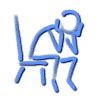American Psychiatric Association (1994). Diagnostic and Statistical Manual of Mental Disorders (4th ed.) Washington, DC: American Psychiatric Assoc.
Bipolar I
is a recurrent disorder - more than 90% of individuals who have a single Manic Episode go on to have future episodes. Roughly 60% - 70% of Manic Episodes occur immediately before or after a Major Depressive Episode. Manic Episodes often precede or follow the Major Depressive Episodes in a characteristic pattern for a particular person. The number of lifetime episodes (both Manic and Major Depressive) tends to be higher for Bipolar I Disorder compared with Major Depressive Disorder, Recurrent. Studies of the curse of Bipolar I Disorder prior to lithium maintenance treatment suggest that, on average, four episodes occur in 10 years. The interval between episodes tends to decrease as the individual ages. (p.353)
Bipolar I Disorder is distinguished from 'Major Depressive Disorder' and 'Dysthymic Disorder' by the lifetime history of at least one Manic or Mixed Episode. Bipolar I Disorder is distinguished from Bipolar II Disorder by the presence of one or more Manic or Mixed Episodes. When an individual previously diagnosed with Bipolar II Disorder develops a Manic or Mixed Episode, the diagnosis is changed to Bipolar I Disorder.
Bipolar I Disorder, Single Manic Episode**
A. Presence of only one Manic Episode** and no past Major
Depressive Episodes****.
Note: Recurrence is defined as either a change in polarity from depression or an interval of at least 2 months without manic symptoms.
B. The Manic Episode is not better accounted for by Schizoaffective Disorder and is not superimposed on Schizophrenia, Schizophreniform Disorder, Delusional Disorder,or Psychotic Disorder Not Otherwise Specified. (p.355)
Bipolar I Disorder, Most Recent Episode Hypomanic*
A. Currently (or most recently) in a Hypomanic Episode*
B. There has previously been at least one Manic Episode** or Mixed Episode***
C. The mood symptoms cause clinically significant distress or
impairment in social, occupational, or other important areas
of functioning.
D. The mood episodes in A and B are not better accounted for by Schizoaffective.....(p.356)
Bipolar I Disorder, Most Recent Episode Manic**
A. Currently (or most recently)in a Manic Episode**
B. There has previously been at least one Major Depressive Episode****, Manic Episode**, or Mixed Episode***
C. The mood episodes in A and B are not better accounted for by Schizoaffective Disorder....(p.356)
Bipolar I Disorder, Most Recent Episode Mixed***
A. Currently (or most recently) in a Mixed Episode***
B. There has previously been at least on Major Depressive Episode****, Manic Episode**, or Mixed Episode***
C. The mood episodes in A and B are not better accounted for by Schizoaffective Disorder ....(p.357)
Bipolar I Disorder, Most Recent Episode Depressed
A. Currently (or most recently) in a Major Depressive Episode****
B. There has previously been at least one Manic Episode** or Mixed Episode***
C. The mood episodes in A and B are not better accounted for by Schizoaffective Disorder....(p.357)

Hypomanic Episode* - a distinct period during which there is an abnormally and persistently elevated, expansive, or irritable mood that lasts at least 4 days. This period of abnormal mood must be accompanied by at least three additional symptoms from a list that includes inflated self-esteem or grandiosity (nondelusional), decreased need for sleep, pressure of speech, flight of ideas, distractability, increased involvement in goal-directed activities or psychomotor agitation, and excessive involvement in pleasurable activities that have a high potential for painful consequences. (p.335)
Manic Episode** - a distinct period during which there is an abnormally and persistently elevated, expansive, or irritable mood. This period of abnormal mood must last at least 1 week (or less if hospitalization is required). The mood disturbance must be accompanied by at least 3 additional symptoms from a list that includes inflated self-esteem or grandiosity, decreased need for sleep, pressure of speech, flight of ideas, distractibility, increased involvement in goal-directed activities or psychomotor agitation, and excessive involvement in pleasurable activities with a high potential for painful consequences. (p.328)
Mixed Episode*** - a period of time (lasting at least 1 week) in which the criteria are met both for a Manic Episode and for a Major Depressive Episode nearly every day. The individual experiences rapidly alternating moods (sadness, irritability, euphoria) accompanied by symptoms of a Manic Episode and a Major Depressive Episode. The symptom presentation frequently includes agitation, insomnia, appetite dysregulation, psychotic features, and suicidal thinking. (p.333)
Major Depressive Episode**** - a period of at least 2 weeks during which there is either dperessed mood or the loss of interest or pleasure in nearly all activities. In children and adolescents, the mood may be irritable rather than sad. The individual must also epxerience at least 4 additional symptoms drawn from a list that includes changes in appetite or weight, sleep, and psychomotor activity, decreased energy; feelings of worthlessness or guilt; difficulty thinking, concentrating, or making decisions; or recurrent thoughts of death or suicidal ideation, plans or attempts.. To count toward a Major Depressive Episode, a symptom must either be newly present or must have clearly worsened compared with the person's pre-episode status. (p.321)
|




